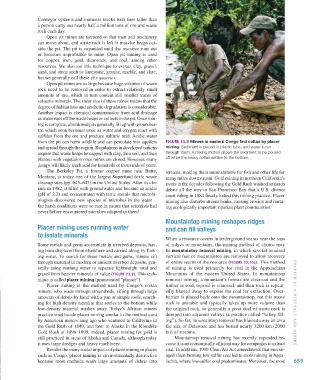Page 660 - Environment: The Science Behind the Stories
P. 660
Conveyor systems and immense trucks with tires taller than
a person carry out nearly half a million tons of ore and waste
rock each day.
Open pit mines are terraced so that men and machinery
can move about, and waste rock is left in massive heaps out-
side the pit. The pit is expanded until the resource runs out
or becomes unprofitable to mine. Open pit mining is used
for copper, iron, gold, diamonds, and coal, among other
resources. We also use this technique to extract clay, gravel,
sand, and stone such as limestone, granite, marble, and slate,
but we generally call these pits quarries.
Open pit mines are so large because huge volumes of waste
rock need to be removed in order to extract relatively small
amounts of ore, which in turn contain still smaller traces of
valuable minerals. The sheer size of these mines means that the
degree of habitat loss and aesthetic degradation is considerable.
Another impact is chemical contamination from acid drainage
as water runs off the waste heaps or collects in the pit. Once min-
ing is complete, abandoned pits generally fill up with groundwa-
ter, which soon becomes toxic as water and oxygen react with
sulfides from the ore and produce sulfuric acid. Acidic water
from the pit can harm wildlife and can percolate into aquifers Figure 23.9 Miners in eastern Congo find coltan by placer
and spread through the region. Regulations in developed nations mining. Sediment is placed in plastic tubs, and water is run
require that waste heaps be capped with clay, then soil, and then through them. A mixing motion allows the sediment to be poured
planted with vegetation once mines are closed. However, many off while the heavy coltan settles to the bottom.
dumps will likely leach acid for hundreds or thousands of years.
The Berkeley Pit, a former copper mine near Butte, streams, making them uninhabitable for fish and other life for
Montana, is today one of the largest Superfund toxic waste many miles downstream. Gold mining in northern California’s
cleanup sites (pp. 645–647) in the United States. After its clo- rivers in the decades following the Gold Rush washed so much
sure in 1982, it filled with groundwater and became so acidic debris all the way to San Francisco Bay that a U.S. district
(pH of 2.2) and concentrated with toxic metals that microbi- court ruling in 1884 finally halted this mining practice. Placer
ologists discovered new species of microbes in the water— mining also disturbs stream banks, causing erosion and harm-
the harsh conditions were so rare in nature that scientists had ing ecologically important riparian plant communities.
never before encountered microbes adapted to them!
Mountaintop mining reshapes ridges
Placer mining uses running water and can fill valleys
to isolate minerals
When a resource occurs in underground seams near the tops
Some metals and gems accumulate in riverbed deposits, hav- of ridges or mountains, the mining method of choice may
ing been displaced from elsewhere and carried along by flow- be mountaintop removal mining, in which several hundred
ing water. To search for these metals and gems, miners sift vertical feet of mountaintop are removed to allow recovery
through material in modern or ancient riverbed deposits, gen- of entire seams of the resource (Figure 23.10a). This method
erally using running water to separate lightweight mud and of mining is used primarily for coal in the Appalachian
gravel from heavier minerals of value (Figure 23.9). This tech- Mountains of the eastern United States. In mountaintop
nique is called placer mining (pronounced “plasser”). removal mining, a mountain’s forests are clear-cut and the
Placer mining is the method used by Congo’s coltan timber is sold, topsoil is removed, and then rock is repeat-
miners, who wade through streambeds, sifting through large edly blasted away to expose the coal for extraction. Over-
amounts of debris by hand with a pan or simple tools, search- burden is placed back onto the mountaintop, but this waste
ing for high-density tantalite that settles to the bottom while rock is unstable and typically takes up more volume than CHAPTER 23 • Min ERA ls A nd Mining
low-density material washes away. Today’s African miners the original rock, so generally a great deal of waste rock is
practice small-scale placer mining similar to the method used dumped into adjacent valleys (a practice called “valley fill-
by American miners long ago who ventured to California in ing”). So far, mountaintop removal has blasted away an area
the Gold Rush of 1849, and later to Alaska in the Klondike the size of Delaware and has buried nearly 3200 km (2000
Gold Rush of 1896–1899. Indeed, placer mining for gold is mi) of streams.
still practiced in areas of Alaska and Canada, although today Mountaintop removal mining has recently expanded be-
it uses large dredges and heavy machinery. cause it is an economically efficient way for companies to extract
Besides the many social impacts of placer mining in places coal. In addition, 1990 Clean Air Act amendments that encour-
such as Congo, placer mining is environmentally destructive aged clean-burning low-sulfur coal led to more mining in Appa-
because most methods wash large amounts of debris into lachia, where low-sulfur coal predominates. Moreover, the most 659
M23_WITH7428_05_SE_C23.indd 659 13/12/14 11:29 AM

